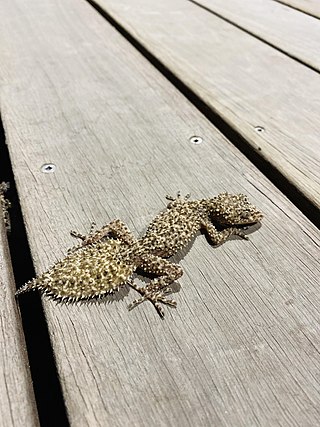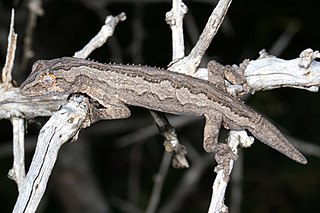
Pygopodidae, commonly known as legless lizards, snake-lizards, or flap-footed lizards, is a family of squamates with reduced or absent limbs, and are a type of gecko. At least 35 species are placed in two subfamilies and eight genera. They have unusually long, slender bodies, giving them a strong resemblance to snakes. Like snakes and most geckos, they have no eyelids, but unlike snakes, they have external ear holes and flat, unforked tongues. They are native to Australia and New Guinea.

Oedura is a genus of medium to large geckos, lizards in the family Diplodactylidae. The genus is endemic to Australia. Species in the genus are referred to by the common name velvet geckos.

Phyllurus is a small genus of Australian leaf-tailed geckos, lizards in the family Carphodactylidae. Rarely seen outside their native habitat, they are notable for their highly effective camouflage which is in part aided by the spiny tubercles that cover every body part.

Underwoodisaurus milii is a species of gecko, a lizard in the family Carphodactylidae. The species is commonly known as the thick-tailed or barking gecko, referring to its distinctive plump tail and sharp, barking defensive call. The genus is also often called thick-tailed geckos as a group, along with the species Uvidicolus sphyrurus.
Uvidicolus is a monotypic genus of lizard in the family Carphodactylidae. The genus contains the sole species Uvidicolus sphyrurus, also known commonly as the border thick-tailed gecko. The species is endemic to Australia.

Burton's legless lizard is a species of lizard in the family Pygopodidae. The species lacks forelegs and has only rudimentary hind legs. Pygopodid lizards are also referred to as "legless lizards", "flap-footed lizards" and "snake-lizards". This species is native to Australia and Papua New Guinea.

The broad-tailed gecko, southern leaf-tailed gecko, or Sydney leaf-tailed gecko is a common gecko of the family Carphodactylidae found in the Sydney Basin. The species uses its mottled colour to camouflage against bark or rock, and if threatened can drop its large fleshy tail as a decoy. The tail is also useful for fat storage. This species of gecko is available in captivity as a pet, they are a nocturnal ambush hunter, relying on camouflage and patience to catch prey. Primary prey items include large nocturnal invertebrates such as spiders, cockroaches and beetles.

The Carphodactylidae, informally known as the southern padless geckos, are a family of geckos, lizards in the infraorder Gekkota. The family consists of 32 described species in 7 genera, all of which are endemic to Australia. They belong to the superfamily Pygopodoidea, an ancient group of east Gondwanan geckos now only found in Australasia. Despite their well-developed limbs, molecular phylogenies have demonstrated that Carphodactylidae is the sister group to Pygopodidae, a highly specialized family of legless lizards.

The Diplodactylidae are a family in the suborder Gekkota (geckos), with over 150 species in 25 genera. These geckos occur in Australia, New Zealand, and New Caledonia. Diplodactylids are the most ecologically diverse and widespread family of geckos in both Australia and New Caledonia, and are the only family of geckos found in New Zealand. Three diplodactylid genera have recently been split into multiple new genera.

Nephrurus levis, commonly known as the three-lined knob-tailed gecko, smooth knob-tailed gecko, or common knob-tailed gecko, is a native Australian gecko species. The smooth knob-tailed gecko is part of the Carphodactylidae family, a family endemic to Australia. A common, alternative, name for this family is barking geckos due loud barks they make during threat displays, which includes swaying their bodies, winding their tail and attacking with an open mouth. There are multiple sub-species of Nephrurus levis, these include N.l. levis, N.l. occidentalis and N.l. pibarenis. Its aboriginal name is Illchiljera.

Strophurus intermedius, also known commonly as the eastern spiny-tailed gecko or the southern spiny-tailed gecko, is a species of lizard in the family Diplodactylidae. The species is endemic to semi-arid regions of Australia in New South Wales, Northern Territory, South Australia, Victoria and Western Australia, in mallee shrubland and woodland habitats.
Nephrurus sheai, also known commonly as the Kimberley rough knob-tailed gecko and the northern knob-tailed gecko, is a species of lizard in the family Carphodactylidae. The species is endemic to Australia.

Nephrurus wheeleri, also known commonly as the banded knob-tailed gecko, the southern banded knob-tailed gecko, and Wheeler's knob-tailed gecko, is a species of lizard in the family Carphodactylidae. The species, like all species of Nephrurus, is endemic to Australia.

Saltuarius salebrosus, also known as the rough-throated leaf-tailed gecko or Central Queensland leaf-tailed gecko, is a gecko found in Australia. It is endemic to dry areas in mid-eastern and south-central Queensland.

Amalosia jacovae, also known commonly as the clouded gecko or the clouded velvet gecko, is a species of lizard in the family Diplodactylidae. The species is endemic to Australia.
The short-tailed striped gecko, also known commonly as McMillan's spiny-tailed gecko, is a species of lizard in the family Diplodactylidae. The species is endemic to Australia.

The Exmouth spiny-tailed gecko, also known commonly as Rankin's spiny-tailed gecko, is a species of lizard in the family Diplodactylidae. The species is endemic to Western Australia.
The Mount Augustus spiny-tailed gecko, also known commonly as the Mount Augustus striped gecko and Wilson's spiny-tailed gecko, is a species of lizard in the family Diplodactylidae. The species is endemic to Australia.

Pygopodoidea is a gecko superfamily and the only taxon in the gekkotan subclade Pygopodomorpha. The clade includes three Australasian families: Diplodactylidae, Carphodactylidae, and Pygopodidae. Traditional gekkotan systematics had considered Diplodactylidae and Carphodactylidae as subfamilies of the family Gekkonidae, but recent molecular work have placed Pygopodidae within Gekkonidae making it paraphyletic. These analyses have shown support of Pygopodidae and Carphodactylidae being sister taxa, with Diplodactylidae occupying a basal position in Pygopodoidea.

The Zuytdorp worm-lizard, also known commonly as Smith's legless lizard, is a species of lizard in the family Pygopodidae. The species is endemic to Australia.















